Key Insights
- Trading volumes, which were inflated due to the Terra collapse in Q2, were down 71.1% while total value locked (TVL) increased 37.9%.
- OSMO completed its first inflation reduction on June 20 dubbed “The Thirdening,” reducing emissions from 300 million per year to 200 million.
- The largest stablecoin issuer, Circle, announced deployment on the Cosmos network, removing the risk of a bridge exploit for USDC.
- The Scambuster Upgrade put an end to nefarious governance proposals, and The Oxygen Update breathes life into Osmosis with new features like TWAP pricing and Stargate Queries.
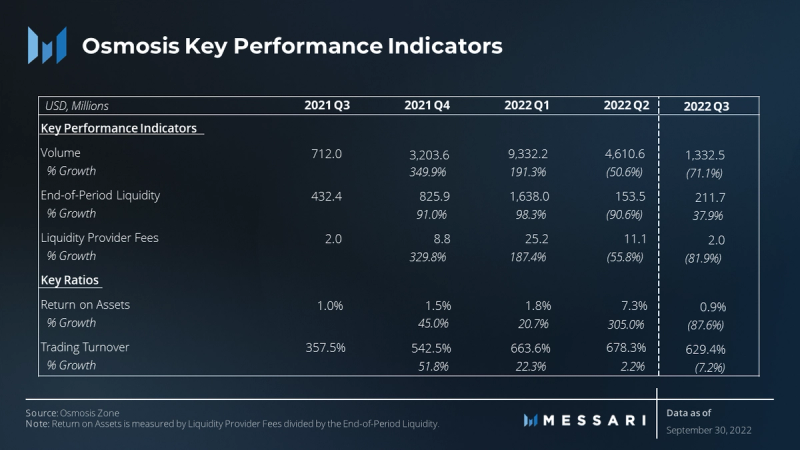
Primer on Osmosis
Osmosis is a sovereign DEX-focused app-chain in the Cosmos ecosystem, meaning it serves simultaneously as a blockchain and an application. The application operates similarly to other AMM functioning DEXs — liquidity providers (LPs) are responsible for supplying liquidity to asset pools for traders. Osmosis places a high priority on offering asset pool customization, allowing changes to market-maker functions, swap costs, token weighting, and more within the DEX.
Introduction
Osmosis and the greater crypto ecosystem finally felt some relief in Q3 after a turbulent Q2. TVL recovered from yearly lows, ending the quarter up 38%, but trading volumes continued to fall, contracting 71%.
Following its first emission reduction, the OSMO token ended the quarter up 53% from its all-time-low on June 18. Total OSMO staked increased 6.3% from the previous quarter.
Currently, there are 53 projects building on Osmosis. They will bring decentralized perpetuals, CDP-based composable collateral, yield optimization, and lending markets to the ecosystem. Circle, the second largest stablecoin issuer, announced it will be launching a Cosmos-native USDC in 2023, signaling a larger interest in the Cosmos ecosystem.
The Osmosis development team is actively working on a number of innovative projects like a new stableswap AMM, interfluid staking, and mesh security.
Performance Analysis
Layer-1 Metrics
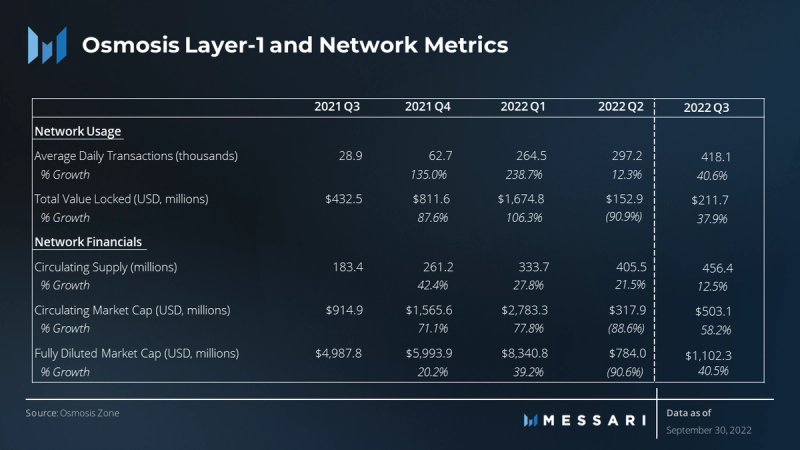
TVL increased 37.9% from the previous quarter and 66% from the yearly low in July. The circulating token supply only grew by 12.5% this quarter, which is the lowest percentage growth QoQ since inception. This reduction in supply growth can be attributed to a one-third emissions reduction of the OSMO token on June 20. The circulating market cap grew 58% on the back of OSMO rallying 36.4% in the quarter.

Average daily transactions increased mostly due to a failed network attack in which the attacker spammed the blockchain with transactions. The attack began on July 18 and continued for 16 days, causing the network to peak at over 2 million daily transactions on July 21. After removing the data from the attack, the number of average daily transactions for the quarter was 144,910, down 51% from the previous quarter. Furthermore, daily active users on Osmosis remained consistent between 20,000 and 30,000 users in Q3.
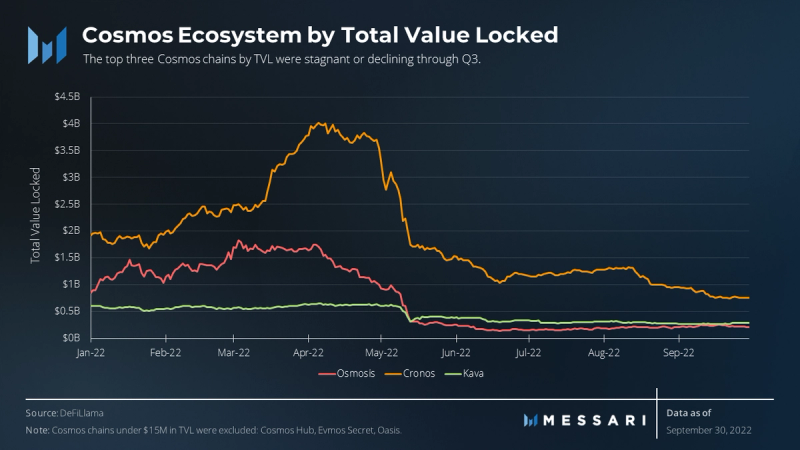
Osmosis currently ranks third amongst Cosmos chains by total value locked, with $211 million in TVL. As TVL, nor any one metric, does not paint the full picture of the health of a network, for Cosmos app-chains the number of IBC connections is another useful data point. Although Osmosis ranks third in TVL, it ranks first in the number of IBC connections with 47. Comparatively, Cronos has 16 IBC connections, and Kava only has 5.
Following the Terra collapse in Q2, TVL on all Cosmos chains suffered from the loss of USTC liquidity. Osmosis’ TVL experienced positive growth in Q3 and increased by 37.9% QoQ. This increase is largely attributed to the rise in the OSMO token price. OSMO climbed 98.3% in the quarter and made up 44.5% of the TVL at its peak on September 17. The introduction of a stATOM/ATOM pool deployed on September 7 also added $10 million TVL by September 17.

The average validator stake increased 39.6% in Q3. At quarter end, Osmosis governance put forth a proposal to increase the active validator set from 135 to 150. The proposal passed on October 3 and should help to further decentralize the network.
Furthermore, developments with mesh security may eventually also help decentralize the network. These efforts to increase the decentralization of the network will benefit Osmosis, especially as crypto users seek to avoid centralized finance (CeFi) disasters like Celsius and the recent BNB chain halt.
DEX Metrics
Trading activity on Osmosis was inflated after the Q2 Terra implosion, and as a result of these inflated numbers, trading activity drastically contracted in Q3. Trading volumes dropped 71.1% in the quarter and over 85.7% from the Q1 highs. Due to lower trading volumes, liquidity provider (LP) swap fees fell 81.9% this quarter, bringing in only $2 million for LPs. Return on assets declined 87.6%, and trading turnover remained relatively constant down 7.2% for the quarter.
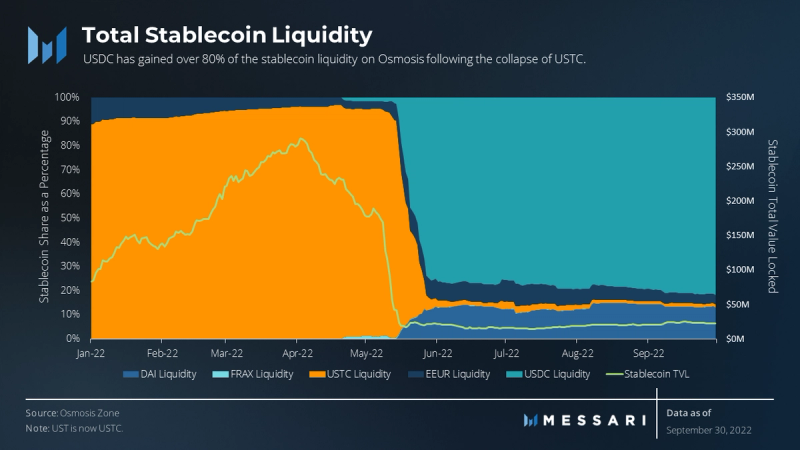
The stablecoin liquidity on Osmosis decreased from nearly $300 million at its peak to just over $22 million. This void in stablecoin liquidity left behind by USTC has been difficult for Osmosis to overcome since there is not a trusted Cosmos-native stablecoin.
Total stablecoin liquidity increased 40.9% in the quarter. The increase was a result of $6.4 million of added bridged USDC liquidity and an additional $980,000 of DAI liquidity.
Since May, USDC has gained the vast majority of market share, but this market share is a fraction of what it used to be. Given that stablecoin pairs make up 62% of the volume on Uniswap’s Ethereum deployment, a trusted stablecoin on Osmosis is crucial. Circle’s plans to launch a Cosmos-native USDC should lead to more stablecoin liquidity on Osmosis. DAI does not seem to have any tailwinds for increased share, despite maintaining a 20% share since USTC’s collapse.
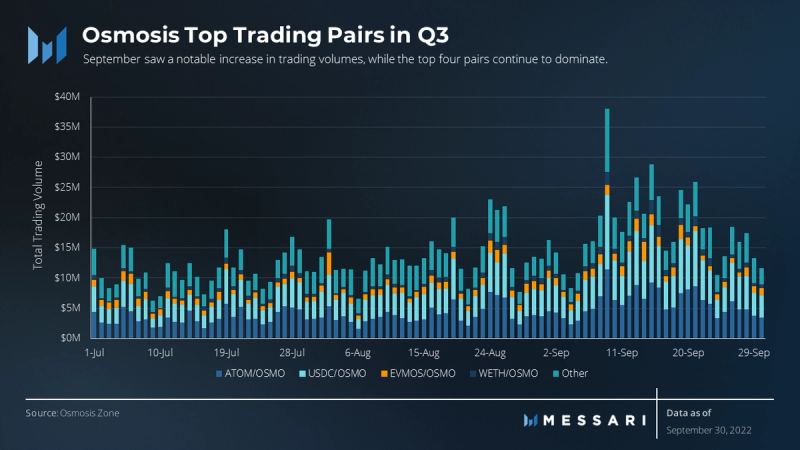
The top four trading pairs on Osmosis consistently account for over 73% of total volumes. Early September experienced a stark increase in volumes, peaking at $38 million up from a quarter low of $6.2 million. The increase in trading volumes was most likely driven by announcements in late September concerning Atom 2.0 and a Cosmos-native USDC. On top of that, Delphi Labs, a collaborative of crypto builders and investors, also announced its move to the Cosmos ecosystem on September 8.
The peak in trading volumes on September 9 was supported by the ATOM/OSMO and USDC/OSMO pools which accounted for 69.8% of trading volumes. The volumes stayed consistently elevated in the month leading up to Cosmoverse on September 26–28 and Converge SF on September 27–30.
OSMO
On June 22, OSMO experienced the first annual emission reduction, which reduced emissions by one third and reduces the yearly inflation of OSMO from 300 million to 200 million. On the back of this emission reduction, OSMO experienced a very positive Q3, ending the quarter up 36.4% in price.
Currently the demand for OSMO is largely driven by users seeking a high yield. OSMO stakers receive a 24.8% APR while the top four OSMO pools earn 22.81%, 77.88%, 72.58%, and 49.9%, respectively. Of the 456 million OSMO circulating, 296 million tokens were either staked or earning yield in a liquidity pool, accounting for 64.9% of the circulating supply.
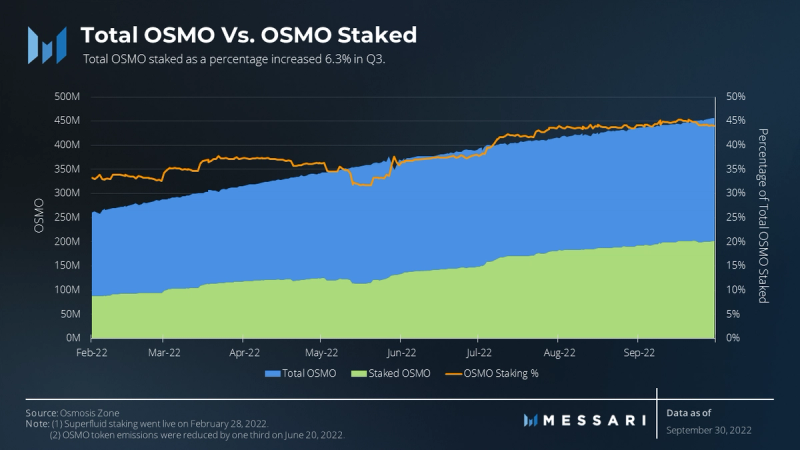
The percentage of total OSMO staked increased 6.3% in Q3, which can be attributed to the double-digit token inflation. If users do not stake their rewards, they face dilution. Superfluid staking, a feature that enables users to stake 50% of their underlying OSMO LP position, has also had a positive impact on the number of OSMO staked since enacted in March 2022.
At the end of Q3, there were 202.2 million OSMO actively staked, up 53.1 million tokens since the start of the quarter. OSMO stakers ended the quarter earning a 24.8% APR in OSMO rewards, down 8.7% QoQ and 27.2% since the first emission reduction on June 20.
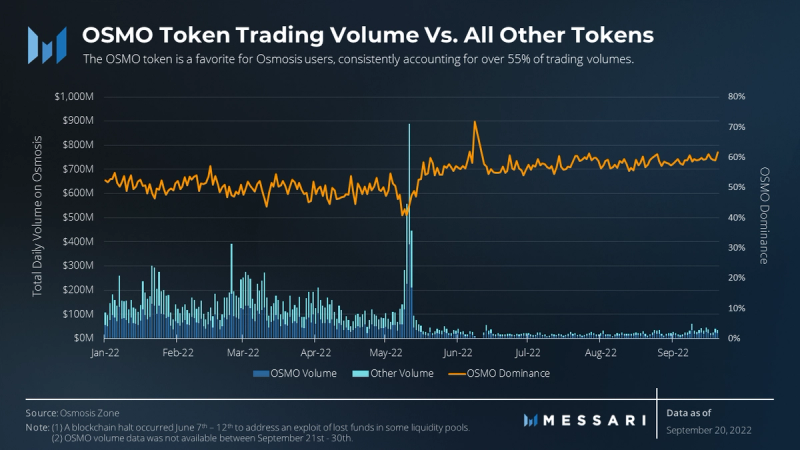
OSMO dominates trading volumes on Osmosis, consistently accounting for over 55% of the volume on the DEX. This is to be expected since OSMO accounts for over 50% of TVL and is paired in 70 out of 121 liquidity pools.
As shown above, the removal of USTC resulted in a noticeable increase in trading dominance. With the introduction of a Cosmos-native USDC, it will be interesting to note whether OSMO dominance returns to levels seen in the first half of 2022.
Qualitative Analysis
The Scambuster Upgrade
On July 22, a nefarious actor attempted to halt the Osmosis blockchain by creating over 20,000 external incentive gauges to overload the validator nodes at the Osmosis epoch block. This attempt to halt the chain only cost the attacker roughly 20 OSMO. Although it was unsuccessful, the attack resulted in Osmosis users dusted with small amounts of tokens that were difficult to get rid of. More importantly, it revealed a potential attack vector.
As a result, The Scambuster Upgrade went live on August 3 with two minor changes. The first change added a 50 OSMO fee to “CreateGauge” and a 25 OSMO fee to “AddToGauge,” significantly increasing the cost of a similar attack. The second change requires users to pay a 125 OSMO deposit for governance proposals, which was later raised to a 400 OSMO deposit via Proposal #304.
The Oxygen Upgrade
The second upgrade in Q3 was more proactive than reactive. The Oxygen Upgrade aims to “breathe life” into the Osmosis developer ecosystem through four distinct features: TWAP pricing, upgraded Interchain Accounts Module, Stargate Queries, and expedited proposals for emergencies.
Moving forward, TWAP pricing will be used for all existing and future liquidity pools on Osmosis instead of block-by-block pricing. This change significantly reduces the likelihood of price manipulation by large players on a block-by-block basis. The feature is meant to prepare for the launching of lending and margin trading protocols onto Osmosis in the near future.
Next, the Interchain Accounts Module from upgrade V9 was initialized to further increase the interoperability between Cosmos chains. V9 will give users on Osmosis access to more opportunities between chains. For example, a user could purchase an asset on Osmosis and stake that asset on its own native Cosmos chain in one single transaction.
The V12 upgrade will also increase interoperability through Stargate Queries, another tool at the disposal of CosmWasm contract developers. Stargate Queries allow developers to query data from chains that are connected to Osmosis via IBC.
The final change from the Oxygen Upgrade is the implementation of expedited proposals for emergency situations. These proposals will require a 5,000 OSMO deposit and allow a proposal to pass as soon as 67% of the voting power approves it. If the proposal does not reach 67% in 24 hours, it reverts to a regular proposal and follows the standard five day voting period.
Looking forward to future upgrades, V13 is anticipated to introduce stableswap AMM logic to improve capital efficiency in stableswap pools. Subsequently, V14 is expected to bring order books to Osmosis. The move will differentiate Osmosis from the majority of DEXs which are currently dominated by the AMM model.
New Players in the Cosmos
DeFi protocols have chosen to build on Osmosis in order to leverage its liquidity and the Cosmos SDK. Currently, there are 53 projects building on Osmosis which will bring decentralized perpetuals, CDP-based composable collateral, yield optimization, and lending markets. As the number of financial primitives on Osmosis increases, metrics like TVL and trading volumes will likely increase, providing greater value to OSMO stakeholders.
In addition to new protocols building on Osmosis, Circle announced plans to issue its USDC stablecoin natively on Cosmos in 2023. Wrapped USDC is currently the largest stablecoin by liquidity and volume on Osmosis. This move by Circle will be hugely impactful because a majority of DEX volume is driven by stablecoins.
Currently, users must trust the security of bridges to use USDC on Osmosis. Given three of the top five exploits by USD value targeted bridges, this is a major security risk. With a Cosmos-native USDC, the risk associated with bridges is eliminated, which should spur an increase in USDC TVL on Osmosis.
Roadmap
On the back of superfluid staking, the Osmosis team is also working on interfluid staking. With interfluid staking, liquidity providers in the ATOM/OSMO pool will be able to also stake 50% of the underlying ATOM in their LP position.
Mesh security is another novel concept under development and announced at Cosmoverse. In its current state, Osmosis has its own validator set defined by OSMO staking with additional security from ATOM stakers. The vision behind mesh security is to allow Osmosis to receive additional security via ATOM stakers and to allow the Cosmos Hub to receive additional security from OSMO stakers. Essentially, mesh security enables the shared security between different Cosmos app-chains, without relying solely on ATOM stakers.
Following the Ethereum Merge in September, MEV has been at the forefront of many debates in the crypto community. Since Osmosis launched, there has been over $6.7 million in MEV.
Targeting this opportunity, Skip has made a proposal to partner with the Osmosis community to identify, capture, and redirect profits from arbitrage opportunities to the community. Although the idea is still being discussed, the potential of capturing MEV at the protocol level could increase OSMO staking rewards, provide transaction fee refunds, and/or provide DAO funding. Critics of the proposal state the costs of developing this module would outweigh the potential rewards.
Closing Summary
Osmosis experienced a reduction in trading volumes for Q3, as has been the narrative for most DEXs. TVL may have experienced positive growth in the quarter, but the growth was largely due to a supply increase in the OSMO token which accounts for over half of the liquidity on Osmosis. Users continued to stake OSMO, with the total percent staked increasing 6.4% over the quarter.
Moving forward, Osmosis continues to be driven by the efforts of its development team. Two upgrades were pushed in the quarter, and announcements of upgrades like mesh security, interfluid staking, and a stableswap AMM have left users excited about what’s to come. A Cosmos-native USDC and revered builders like Delphi Labs should bring exciting new opportunities to Osmosis beyond just a DEX. Lending, perpetual trading, and leveraged farming will all likely increase activity on the blockchain, bringing greater value to OSMO holders.
Let us know what you loved about the report, what may be missing, or share any other feedback by filling out this short form.
This report was commissioned by Osmosis, a member of Protocol Services. All content was produced independently by the author(s) and does not necessarily reflect the opinions of Messari, Inc. or the organization that requested the report. Paid membership in Protocol Services does not influence editorial decisions or content. Author(s) may hold cryptocurrencies named in this report. Crypto projects can commission independent research through Protocol Services. For more details or to join the program, contact ps@messari.io. This report is meant for informational purposes only. It is not meant to serve as investment advice. You should conduct your own research, and consult an independent financial, tax, or legal advisor before making any investment decisions. The past performance of any asset is not indicative of future results. Please see our Terms of Use for more information.




















